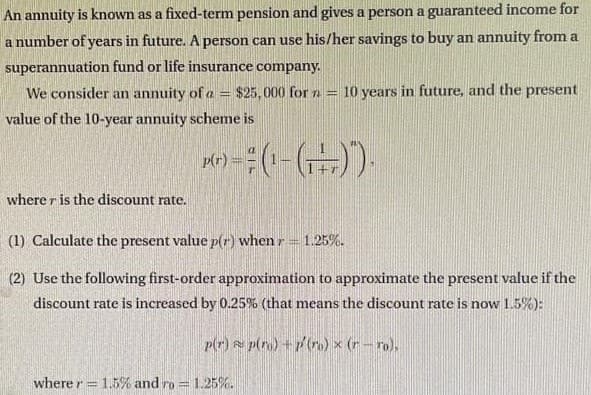An annuity is known as a fixed-term pension and gives a person a guaranteed income for a number of years in future. A person can use his/her savings to buy an annuity from a superannuation fund or life insurance company. We consider an annuity of a $25,000 for n = 10 years in future, and the present value of the 10-year annuity scheme is p(r) = (¹ - (,)"). wherer is the discount rate. (1) Calculate the present value p(r) when r = 1.25%. (2) Use the following first-order approximation to approximate the present value if the discount rate is increased by 0.25% (that means the discount rate is now 1.5%): p(r) p(ro) + p'(ro) x (r-ro). where r= 1.5% and ro 1.25%. Sel
An annuity is known as a fixed-term pension and gives a person a guaranteed income for a number of years in future. A person can use his/her savings to buy an annuity from a superannuation fund or life insurance company. We consider an annuity of a $25,000 for n = 10 years in future, and the present value of the 10-year annuity scheme is p(r) = (¹ - (,)"). wherer is the discount rate. (1) Calculate the present value p(r) when r = 1.25%. (2) Use the following first-order approximation to approximate the present value if the discount rate is increased by 0.25% (that means the discount rate is now 1.5%): p(r) p(ro) + p'(ro) x (r-ro). where r= 1.5% and ro 1.25%. Sel
College Algebra
7th Edition
ISBN:9781305115545
Author:James Stewart, Lothar Redlin, Saleem Watson
Publisher:James Stewart, Lothar Redlin, Saleem Watson
Chapter8: Sequences And Series
Section8.4: Mathematics Of Finance
Problem 2E
Related questions
Question

Transcribed Image Text:An annuity is known as a fixed-term pension and gives a person a guaranteed income for
a number of years in future. A person can use his/her savings to buy an annuity from a
superannuation fund or life insurance company.
S
We consider an annuity of a $25,000 for n = 10 years in future, and the present
value of the 10-year annuity scheme is
p(r) = (¹ - (,)").
wherer is the discount rate.
(1) Calculate the present value p(r) when r = 1.25%.
(2) Use the following first-order approximation to approximate the present value if the
discount rate is increased by 0.25% (that means the discount rate is now 1.5%):
p(r)
p(ro) + p'(ro) x (r-ro).
where r= 1.5% and ro
1.25%.
Sel
Expert Solution
This question has been solved!
Explore an expertly crafted, step-by-step solution for a thorough understanding of key concepts.
Step by step
Solved in 3 steps with 3 images

Recommended textbooks for you

College Algebra
Algebra
ISBN:
9781305115545
Author:
James Stewart, Lothar Redlin, Saleem Watson
Publisher:
Cengage Learning

College Algebra
Algebra
ISBN:
9781305115545
Author:
James Stewart, Lothar Redlin, Saleem Watson
Publisher:
Cengage Learning